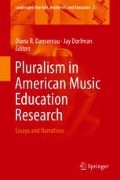Abstract
Globalization has changed the social, cultural, and linguistic diversity in societies all over the world (Blommaert, J & Rampton, B. Diversities, 13(2), 1–22 (2011)). As new technologies have rapidly developed alongside increased forms of transnational flow, so have new forms of language, art, music, communication, and expression. This rapid and varied blending of cultures, ideas, and modes of communication is what Vertovec (2007) describes as super-diversity—diversity within diversity. In this narrative, I explore the theoretical and methodological pluralism that has aided my research in diverse settings, drawing from post-structuralism, critical theory, sociolinguistics, complexity theory, and discourse analysis—specifically Scollon and Scollon’s (Scollon, R & Scollon, W S. Discourses in place: Language in the material world. London: Routledge (2003), 10.4324/9780203422724; Scollon, R & Scollon, W S. Nexus analysis: Discourse and the emerging internet. New York: Routledge (2004)) recommendations for nexus analysis and Blommaert’s theoretical principles and concepts of ethnography, globalization, and superdiversity (Blommaert, J. Discourse. Cambridge, UK: Cambridge University Press (2005), 10.1017/CBo9780511610295; Blommaert, J. The sociolinguistics of globalization. Cambridge, UK: Cambridge University Press (2010), 10.1017/CBO9780511845307; Blommaert, J. Ethnography, superdiversity and linguistic landscapes: Chronicles of complexity. Bristol, UK: Multilingual Matters (2013)). I promote a need to develop a robust toolkit for music education that (1) better analyzes how we position and are positioned as part of larger groups and practices operating within multiple layers of social, cultural, and historical context, and (2) better advocates for equitable practices and inclusive spaces in our field.
Access this chapter
Tax calculation will be finalised at checkout
Purchases are for personal use only
References
Agha, A. (2007). Language and social structure. Cambridge, UK: Cambridge University Press.
Blommaert, J. (2005). Discourse. Cambridge, UK: Cambridge University Press. https://doi.org/10.1017/CBo9780511610295
Blommaert, J. (2010). The sociolinguistics of globalization. Cambridge, UK: Cambridge University Press. https://doi.org/10.1017/CBO9780511845307
Blommaert, J. (2013). Ethnography, superdiversity and linguistic landscapes: Chronicles of complexity. Bristol, UK: Multilingual Matters.
Blommaert, J. (2015). Pierre Bourdieu: Perspectives on language in society. In J.-O. Östman & J. Verschueren (Eds.), The handbook of pragmatics (pp. 1–16). Amsterdam, Netherlands: John Benjamins.
Blommaert, J., & Rampton, B. (2011). Language and superdiversity. Diversities, 13(2), 1–22.
Foucault, M. (1972). The archaeology of knowledge and the discourse on language. (A. M. Sheridan Smith, Trans.). New York: Pantheon Book.
Gee, J. (2005). An introduction to discourse analysis: Theory and method (2nd ed.). London: Routledge.
Irvine, J. T., & Gal, S. (2000). Language ideology and lingusitic differentiation. In P. V. Kroskrity (Ed.), Regimes of language: Ideologies, polities, and identities (pp. 35–84). Santa Fe, NM: School of American Research Press.
Lave, J., & Wenger, E. (1991). Situated learning: Legitimate peripheral participation. Cambridge, UK: Cambridge University Press.
Parkin, D. (2013). Concluding comments. In Blommaert, J., Rampton, B., & Spotti, M. (eds). Language and Superdiversity, Part 2 Special issue of Diversities 14(2), 71–83.
Rampton, B. (2006). Language in late modernity. Cambridge, UK: Cambridge University Press.
Scollon, R., & Scollon, W. S. (2003). Discourses in place: Language in the material world. London: Routledge. https://doi.org/10.4324/9780203422724
Scollon, R., & Scollon, W. S. (2004). Nexus analysis: Discourse and the emerging internet. New York: Routledge.
Silverstein, M. (2003). Indexical order and the dialectics of sociolinguistic life. Language & Communication, 23, 193–229.
Talbot, B. C. (2012). Finding a way: Discourse analysis of music transmission in Gamelan Eka Sruti Illini and implications for music education. Saarbrücken, Deutschland: Lambert Academic Publishing.
Talbot, B. C. (2013). Discourse analysis as potential for re-visioning music education. Action, Criticism & Theory for Music Education, 12(1), 47–63.
Vertovek, S. (2007). Super-diversity and its implications. Ethnic and Racial Studies, 30(6), 1024–1054.
Wertsch, J. V. (1998). Mind as action. Oxford, UK: Oxford University Press.
Wodak, R. (1995). Critical linguistics and critical discourse analysis. In J. Verschueren et al. (Eds.), Handbook of pragmatics: Manual (pp. 204–210). Amsterdam: John Benjamins.
Author information
Authors and Affiliations
Corresponding author
Editor information
Editors and Affiliations
Rights and permissions
Copyright information
© 2018 Springer International Publishing AG, part of Springer Nature
About this chapter
Cite this chapter
Talbot, B.C. (2018). Superdiversity in Music Education. In: Dansereau, D., Dorfman, J. (eds) Pluralism in American Music Education Research. Landscapes: the Arts, Aesthetics, and Education, vol 23. Springer, Cham. https://doi.org/10.1007/978-3-319-90161-9_10
Download citation
DOI: https://doi.org/10.1007/978-3-319-90161-9_10
Published:
Publisher Name: Springer, Cham
Print ISBN: 978-3-319-90160-2
Online ISBN: 978-3-319-90161-9
eBook Packages: EducationEducation (R0)

